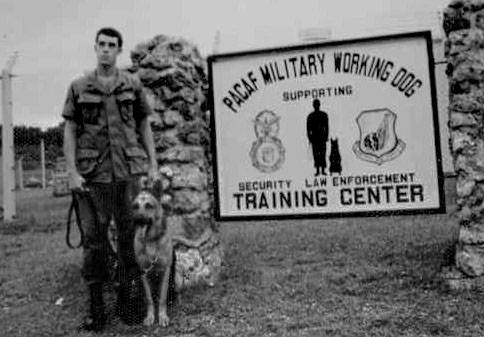MWDTC Staff (In Fatigues) & HQ PACAF SP Staff (In Blue's) Circa 1980 In at least two cases, the dogs returned to temporary active duty. Two dogs were adopted by dog school instructors. They returned to the school to be handled by student in drug detector dog classes. The original dogs belonging to the students were eliminated from the course due to substandard performance. By continuing with the SSD's, the students could graduate and return to their bases. They could be assigned to a trained drug detector dog, and start working. After completing the courses, the two dogs returned to civilian life. Both dogs were adopted by MWDTC personnel. Butch SSD (Small Sniffer Dog) # 56, was adopted by my wife (SSgt Cathy Moore, MWDTC Instructor) & myself. He was aggressive but adopted well to home life with us. He returned to active duty once to assist a handler's whose dog had had not progressed in training. Butch would go to school with us, and be turned over to his temporary handler. Butch remembered his days as an AF drug detector dog and the handler completed his course. Several years after the start of PACAF's program, the Lackland Dog School researched the concept of training small breed dogs to determine if poodles, beagles, terriers, and schnauzers would be better detector dogs. The school purchased registered purebreds dogs and spent several years training various small breeds as drug or explosive detector dogs. Nothing came of their test program. In 1979, a political struggle ensued that eventually led to the end of the PACAF MWDTC. A large shipment of dogs arrived from the DOD Dog Center without the accompanying mandated full sets of dog equipment. DOD Dog Center regulations stated that each dog would be shipped with one complete set of dog equipment. The DOD Dog Center was reminded of this via message. The DOD Dog Center complained about the tone of the message to Headquarters AF Security Police. This became the catalyst for great changes to PACAF MWDTC. A meeting was held at PACAF HQ to determine the future of the school. The decision was made to turn the school over to Air Training Command (ATC). In late 1980 Representatives from Lackland Air Force Base Dog School arrived to inspect the Center. The ATC inspectors were not pleased to discover that the school was not using their Course Materials. The school had rewritten all materials for the local conditions found in the Pacific area. Request for course materials from the Lackland Dog School had never been complied with. The majority of the PACAF MWDTC instructors had taught at the Lackland Dog School and had adopted their course materials to local conditions. The inspectors were also displeased to discover that the school had been shipping drugs to all bases in the PACAF area for use in narcotic detector dog training. The drugs would be shipped to the dog school from other overseas bases that had made large seizures. The drugs were tested, carefully weighed, and shipped to bases that needed samples for their drug dogs. Stateside bases procured their training aids (Drug samples) from DEA sources. The same DEA form that stateside civilian pharmacies use in ordering prescription drugs was used. The DEA could not ship drugs to overseas bases. Air Force Headquarters had never provided for drug training aids for overseas detector dogs. That problem had always been left up to the individual commands to solve. The PACAF MWDTC has filled the void by both supplying the substances and by auditing the training aids during yearly staff assistance visits. We called it a visit, the bases called it an inspection. We provided a written report to the Security Police unit commander and Headquarters PACAF Security Police. The school also had a long tradition of sending instructors to bases to teach classes that was also not well received by the ATC Inspectors. The "traveling" dog school courses had been a very cost-effective method for units to train dog handlers and reduce student-training costs. It was far less expensive to send one or two instructors to a base than a greater number of students and their dogs to Kadena. Previously, PACAF MWDTC instructors went to bases throughout the Pacific area; courses were taught for the US 8th Army at Camp Carroll, Korea, and the US Navy at Subic Bay, Republic of the Philippines. The school even taught members of the Honolulu Police Department. Because of Hawaii's strict quarantine of all dogs arriving it was cheaper to send an instructor to teach an explosive detector class for one dog than ship the dog to the mainland. During one field course taught at Osan AB, Korea, 14 students were trained from all the in country bases. The bases split the funding for the two instructors; all the students stayed in the Osan Security Police barracks. Thus, those drug detector dog teams were available at a minimum cost to the bases. During the course, the instructors saved 12 Army Sentry Dogs. One afternoon, an U.S. Army truck loaded with the dogs in shipping crates pulled into the Osan AB kennels. The dogs were from an Army Air Defense battery that had been turned over to the Korean military. The dogs were declared excess and were en route to an Army veterinarian to be put to sleep. Accompanying Army handlers desperately were searching for an U.S. military kennels that sign the receipt for the dogs and save them from death. One of the dogs was less than 2 years old and had been in country less than 6 months. There was no time for any long distance decisions or approval from the DOD Dog Center. The senior instructor signed for the dogs; the Osan Kennelmaster offered extra available kennels for the dogs. The drug dog students volunteered their free time to retrain the sentry dogs into patrol dogs. Afternoon patrol dog training commenced after the morning's drug detector training sessions. Controlled aggression was successfully introduced to the dogs. The dogs were then assigned to Air Bases in Korea with the longest standing orders (MILSTRIPS) for patrol dogs from Lackland. Several MILSTRIPS were years old.
The ATC representatives, who inspected the Center, informed us that the dogs had been the Army's problem and should have been put to sleep. Before ATC takeover, staff assistance visits had been conducted at all PACAF bases with dogs. These were not merely the IG-type inspection. Assistance was given to the kennels to solve problem areas and the Military Working Dog Supervisors Course was taught at all locations. This course was geared toward the non-dog handler to ensure proper utilization of dogs. In early 1981, the PACAF MWDTC was converted to an Air Training Command (ATC) Field Training Detachment, under the control of the Lackland Dog School. ATC staff at Lackland AFB, Texas, determined class schedules. Instructors were no longer allowed to travel to any base and teach classes there. The school was informed that no exception would be allowed. Under ATC, the school was not allowed to provide the same previous level of support to PACAF bases. ATC's stranglehold and policy changes slowly reduced the student load over several years and enabled the closure of the former training center, citing its diminished use. Air bases were required to send students back to Lackland for training, which dramatically increased TDY costs. Bases lacking funding had dogs sitting idle in the their kennels. Within a few years, ATC had the justification to close the school.
Photo Above: Lower Training Area, The Quonset Huts (right background) were also used as the former barracks area for students. In the late 70's it was used for detection training and building search by patrol dog classes. Building in the left background was the kennels belonging to the Kadena Air Base's Security Police Squadron (18th SPS).
|






